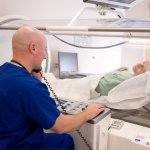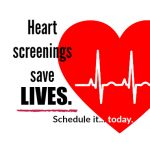By Carrie Perrien Smith
 We’re not spring chickens anymore but we still do a better job of taking care of the ones we love than we do ourselves. When we neglect our own health, we eventually can’t take care of anyone or enjoy life to its fullest.
We’re not spring chickens anymore but we still do a better job of taking care of the ones we love than we do ourselves. When we neglect our own health, we eventually can’t take care of anyone or enjoy life to its fullest.
And if you are like me, you’ve attended a few funerals for people who fell to heart disease far too young. Ladies, it’s time we put our heart health at the top of our list of priorities.
Disclaimer: I am not a doctor even though this resembles medical advice. I will confess to being an internet jockey who has pulled together a few links to save some lives.
February is Heart Health Month
Heart disease is the number one killer of women. I can’t think of a better month to place a focus on your heart health. Even if you won’t do it for yourself, do it for the people who you love and influence in your life. You make a difference in our world.
The American Heart Association uses the term heart disease to describe “several problems related to plaque buildup in the walls of the arteries, or atherosclerosis. As the plaque builds up, the arteries narrow, making it more difficult for blood to flow and creating a risk for heart attack or stroke. … Other types of heart disease include heart failure, an irregular heartbeat – or arrhythmia – and heart valve problems.”
Click here for a definition of each of those conditions.
Evaluate Your Risk
Know the risk factors. If you have a history of smoking, diabetes, being overweight, high blood pressure or cholesterol, high-stress living, or being inactive, you are at a higher risk. Research has connected gum disease and heart disease as well. Family history is a factor worth noting too. Television heart expert, Dr. Oz, says, “Our genes load the gun but our lifestyle pulls the trigger.”
There are many risk calculators on the internet. If you know your blood pressure and cholesterol numbers, take the American Heart Association’s Heart Risk Assessment HERE.
Don’t know your numbers? Get tested — this week!
Make Your Health a Priority
You can reduce your risk. No matter how you’ve treated your body over the years, you can improve your future by making changes now. Simple lifestyle changes such as walking thirty minutes a day and eating a heart-healthy diet can chip away at your risk. They improve your heart health and reduce your weight, blood pressure, and cholesterol.
A WebMD.com article titled Periodontal Disease and Heart Health shares information on the possible connection: “The evidence isn’t clear yet, experts say, but it’s intriguing. According to the American Academy of Periodontology, people with periodontal disease are almost twice as likely to have coronary artery disease (also called heart disease). And one study found that the presence of common problems in the mouth, including gum disease (gingivitis), cavities, and missing teeth, were as good at predicting heart disease as cholesterol levels.”
I’m not taking any chances. Flossing is part of my daily dental routine in my fight to avoid heart disease (and dentist visits that require shots in my mouth).
Prepare Yourself to Act
If you haven’t taken CPR in a few years, consider taking a class. It will equip you with the skills to save a family member or friend. Today, medical professionals are encouraging us to do continuous chest compression CPR for adults.
Know the Signs of Heart Attack and Stroke
Knowing the signs and acting quickly are the keys to survival and recovery.
The American Heart Association lists these heart attack warning signs:
- Chest discomfort. Most heart attacks involve discomfort in the center of the chest that lasts more than a few minutes, or that goes away and comes back. It can feel like uncomfortable pressure, squeezing, fullness, or pain.
- Discomfort in other areas of the upper body. Symptoms can include pain or discomfort in one or both arms, the back, neck, jaw, or stomach.
- Shortness of breath with or without chest discomfort.
- Other signs may include breaking out in a cold sweat, nausea, or lightheadedness.
The American Heart Association uses the F.A.S.T. acronym to help us remember the signs of a stroke.
- Face Drooping. Does one side of the face droop or is it numb? Ask the person to smile.
- Arm Weakness. Is one arm weak or numb? Ask the person to raise both arms. Does one arm drift downward?
- Speech Difficulty. Is speech slurred, are they unable to speak, or are they hard to understand? Ask the person to repeat a simple sentence, like “the sky is blue.” Is the sentence repeated correctly?
- Time to call 911. If the person shows any of these symptoms, even if the symptoms go away, call 9-1-1 and get them to the hospital immediately.
They also list other symptoms such as sudden numbness or weakness of the leg; sudden confusion or trouble understanding; sudden trouble seeing; sudden difficultly walking, dizziness, loss of balance, or coordination; or sudden severe headache with no known cause.
Set the Standard for the Rest of Your Loved Ones
You are the most powerful example to your family. When you adopt changes to improve, you demonstrate to others how it can be done. When they see a healthier you, it will inspire them to create their own healthy lifestyle changes.
All eyes are on you. What changes are you going to make?
 Carrie Perrien Smith is mama to Darcie and a pack of black dogs (Snappy, Jazmin, and Midgieboy — in pack order), grandma to Robert, wife to world-traveler and Walmart-blue-bleeding Tom, daughter to Wayne and Phyllis, speaker bureau and publishing company owner, Business: Engaged! small business radio show host,
Carrie Perrien Smith is mama to Darcie and a pack of black dogs (Snappy, Jazmin, and Midgieboy — in pack order), grandma to Robert, wife to world-traveler and Walmart-blue-bleeding Tom, daughter to Wayne and Phyllis, speaker bureau and publishing company owner, Business: Engaged! small business radio show host, community activist, singer in a party band, and home improvement junkie. Follow her on Twitter @soarwitheagles or contact her at carrie@soarhigher.com.





